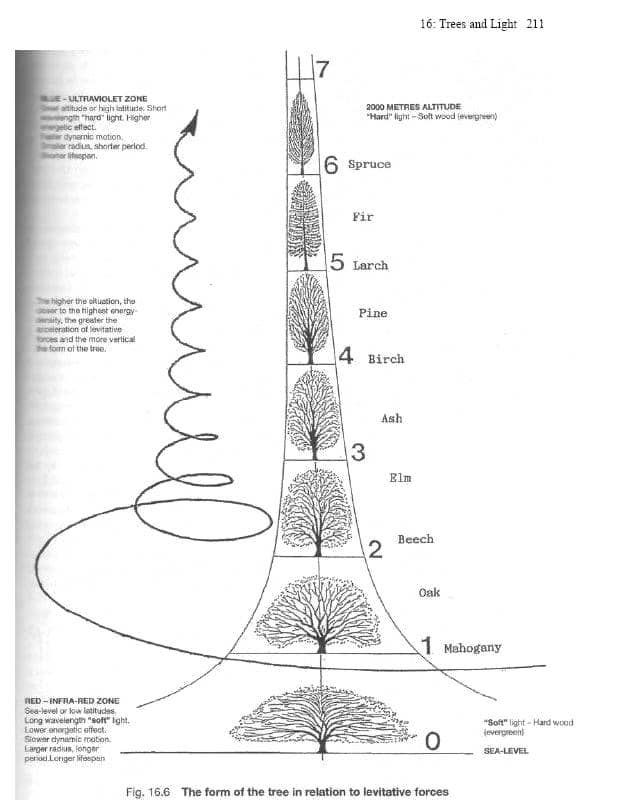
tree
A tree's bark protects the living tissue called cambium, which produces new bark and new wood. Phloem transports new materials from crown to roots; when it dies, it becomes bark. Xylem moves water from roots to crown; when it dies, it forms the heartwood. [source: Colorado Forest Service]
Schauberger
Therefore it is also a mistake to believe that plants breathe in carbones and breathe out oxygen, which can be proven as follows: If the tips of enclosed stands of conifers are observed on very warm and windless days at about noon, then delicate transparent wraiths of mist can be seen, which waft upwards and disintegrate on exposure to excessive light and heat.[15] This is a sign that decentrating forms of emulsion are taking place. That is, the upwardly radiating carbones, which become passive (inactive) with strong light and heat, are being bound by the aggressive oxygen influence, which happens under a negative (rising) temperature gradient. In my own experience this also leads to the drying up of high-lying true springs, which can only rise under conditions where the oxygen is in a diffuse state. If these vapour formations appear above the tops of the trees, then it is certain to rain after about 4 hours. This prompted watchful foresters of old, who were close to Nature, to pack a raincloak in their rucksacks for the afternoon shift. If the opposite emulsive process takes place, i.e. if the downwardly radiating terrestrial energy, which becomes highly active under a positive (falling) temperature gradient, binds the excess oxygen, which becomes passive [The Energy Evolution - Harnessing Free Energy from Nature, The Catalysts]
[15] "Every mm3 of water contains about 10,000 billion water molecules. Each contributes to the cooling effect of evaporation. Droplets rise in spiral paths towards the light (photophoresis)." Walter Schauberger, Implosion Magazine, No. 5, p. 29.
"In mixed forests all the species of trees have different root systems. There are flat-rooted, heart-rooted and deep-rooted trees. The root zone is thus widely diversified and reaches a depth of about 5 metres. Such a forest cannot be torn apart by storms."
Aloys Kokaly, Implosion Magazine No. 54/55, p. 39.
"In the growing season, 1 hectare of forest evaporates about 50,000 litres of water, or 50 m3 per day. in the process a quantity of heat will be extracted through evaporative cooling, which is sufficient to cool 3 million litres of water by 10°C. The sap in the stomata under the surface of the leaves is over-cooled, thereby becoming heavier and sinks down to the root-area, which it then cools, creating a zone of coolness, whereas the warmer and lighter sap rises in the sap ducts. (From an infinite number of the tiny stomata in the leaves and needles, which represent the finest imaginable sieve, the spiralling light ray draws out the minute particle of water and screws it up into the sky.)" Aloys Kokaly, Implosion Magazine, No. 62, p. 10. — Ed. [The Energy Evolution - Harnessing Free Energy from Nature, The Catalysts]

See Also
